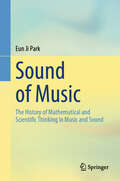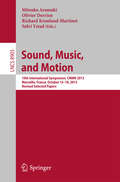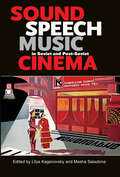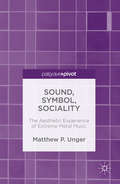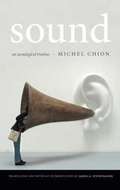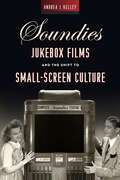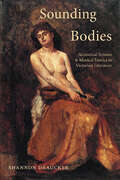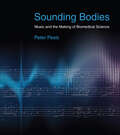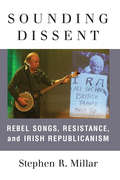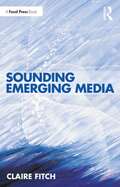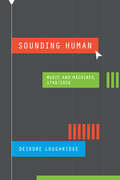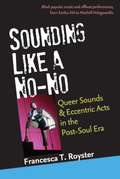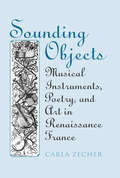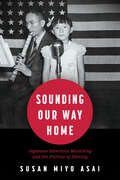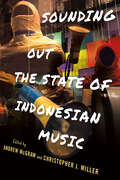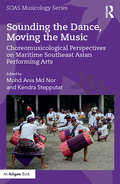- Table View
- List View
Sound of Music: The History of Mathematical and Scientific Thinking in Music and Sound
by Eun Ji ParkThis book explains that the essence of music lies in intangible mental realms. While vibrations generate sound, and sound forms music, music represents something far beyond mere phenomena—a higher form of expression. This book describes how vibrations are transmitted to the human ear, stirring emotions and ultimately moving the soul. This complex process defies full comprehension. Nevertheless, humanity has long sought to uncover the secrets of music and sound, striving since ancient times to objectively interpret them. This book begins by exploring this endeavor as both a way of observing phenomena and attempting to understand the world, posing the following questions: How have we interpreted music and sound throughout history? What origins have we ascribed to music and sound? How have we analyzed sound phenomena with different technologies up to the present day? Throughout history, scholars have observed and analyzed music and sound from different perspectives, initially seeking to understand sound through numerical frameworks and later employing scientific experimentation to analyze it more precisely. The observations and theories discovered along the way have established a rich body of knowledge, enabling us to accurately understand sound phenomena through mathematics and science. This book emphasizes that the artistic domain of music and the scientifically analyzed realm of sound are bound in an inseparable, symbiotic relationship. It argues that those who truly wish to understand music must acquire knowledge of sound. The quality of sound (La qualité du Son), as this book demonstrates, plays a crucial role in shaping the emotional impact of music, with listeners&’ experiences varying significantly based on sound quality. In some respects, sound itself may play an even more important role than any other aspect in forming music. Ultimately, this book provides foundational knowledge of music and sound from diverse perspectives while explaining their connections within the historical contexts of music and science.
Sound of the Beast: The Complete Headbanging History of Heavy Metal
by Ian ChristeThe definitive history of the first 30 years of heavy metal, containing over 100 interviews with members of Black Sabbath, Metallica, Judas Priest, Twisted Sister, Slipknot, Kiss, Megadeth, Public Enemy, Napalm Death, and more. More than 30 years after Black Sabbath released the first complete heavy metal album, its founder, Ozzy Osbourne, is the star of The Osbournes, TV's favourite new reality show. Contrary to popular belief, headbangers and the music they love are more alive than ever. Yet there has never been a comprehensive book on the history of heavy metal - until now. Featuring interviews with members of the biggest bands in the genre, Sound of the Beast gives an overview of the past 30-plus years of heavy metal, delving into the personalities of those who created it. Everything is here, from the bootlegging beginnings of fans like Lars Ulrich (future founder of Metallica) to the sold-out stadiums and personal excesses of the biggest groups. From heavy metal's roots in the work of breakthrough groups such as Black Sabbath and Led Zeppelin to MTV hair metal, courtroom controversies, black metal murderers and Ozzfest, Sound of the Beast offers the final word on this elusive, extreme, and far-reaching form of music.
Sound, Music, and Motion
by Mitsuko Aramaki Olivier Derrien Richard Kronland-Martinet Sølvi YstadThis book constitutes the thoroughly refereed post-conference proceedings of the 10th International Symposium on Computer Music Modeling and Retrieval, CMMR 2013, held in Marseille, France, in October 2013. The 38 conference papers presented were carefully reviewed and selected from 94 submissions. The chapters reflect the interdisciplinary nature of this conference with following topics: augmented musical instruments and gesture recognition, music and emotions: representation, recognition, and audience/performers studies, the art of sonification, when auditory cues shape human sensorimotor performance, music and sound data mining, interactive sound synthesis, non-stationarity, dynamics and mathematical modeling, image-sound interaction, auditory perception and cognitive inspiration, and modeling of sound and music computational musicology.
Sound, Sin, and Conversion in Victorian England (Music in Nineteenth-Century Britain)
by Julia Grella O'ConnellThe plight of the fallen woman is one of the salient themes of nineteenth-century art and literature; indeed, the ubiquity of the trope galvanized the Victorian conscience and acted as a spur to social reform. In some notable examples, Julia Grella O’Connell argues, the iconography of the Victorian fallen woman was associated with music, reviving an ancient tradition conflating the practice of music with sin and the abandonment of music with holiness. The prominence of music symbolism in the socially-committed, quasi-religious paintings of the Pre-Raphaelites and their circle, and in the Catholic-Wagnerian novels of George Moore, gives evidence of the survival of a pictorial language linking music with sin and conversion, and shows, even more remarkably, that this language translated fairly easily into the cultural lexicon of Victorian Britain. Drawing upon music iconography, art history, patristic theology, and sensory theory, Grella O’Connell investigates female fallenness and its implications against the backdrop of the social and religious turbulence of the mid-nineteenth century.
Sound, Speech, Music in Soviet and Post-Soviet Cinema
by Masha Salazkina Lilya KaganovskyThis innovative volume challenges the ways we look at both cinema and cultural history by shifting the focus from the centrality of the visual and the literary toward the recognition of acoustic culture as formative of the Soviet and post-Soviet experience. Leading experts and emerging scholars from film studies, musicology, music theory, history, and cultural studies examine the importance of sound in Russian, Soviet, and post-Soviet cinema from a wide range of interdisciplinary perspectives. Addressing the little-known theoretical and artistic experimentation with sound in Soviet cinema, changing practices of voice delivery and translation, and issues of aesthetic ideology and music theory, this book explores the cultural and historical factors that influenced the use of voice, music, and sound on Soviet and post-Soviet screens.
Sound, Symbol, Sociality
by Matthew P. UngerBased on ethnographic research within the extreme metal community, Unger offers a thought-provoking look at how symbols of authenticity and defilement fashion social experience in surprising ways. Exploring the many themes and ciphers that comprise this musical community, this book interprets aesthetic resonances as a way to understand contemporary identity, politics, and social relations. In the end, this book develops a unique argument: the internal composition of the community's music and sound moulds symbols that shape, reflect, and constrain social patterns of identity, difference, and transgression. This book contributes to the sociology of sound and music, the study of religion in popular culture, and the role of aesthetics in everyday life. It will be of interest to upper level students, post-graduate students and scholars of religion, popular culture, and philosophy.
Sound: An Acoulogical Treatise
by James A. Steintrager Michel ChionFirst published in French in 1998, revised in 2010, and appearing here in English for the first time, Michel Chion's Sound addresses the philosophical, interpretive, and practical questions that inform our encounters with sound. Chion considers how cultural institutions privilege some sounds above others and how spurious distinctions between noise and sound guide the ways we hear and value certain sounds. He critiques the tenacious tendency to understand sounds in relation to their sources and advocates "acousmatic" listening--listening without visual access to a sound's cause--to disentangle ourselves from auditory habits and prejudices. Yet sound can no more be reduced to mere perceptual phenomena than encapsulated in the sciences of acoustics and physiology. As Chion reminds us and explores in depth, a wide range of linguistic, sensory, cultural, institutional, and media- and technologically-specific factors interact with and shape sonic experiences. Interrogating these interactions, Chion stimulates us to think about how we might open our ears to new sounds, become more nuanced and informed listeners, and more fully understand the links between how we hear and what we do.
Soundgarden: New Metal Crown
by Chris NicksonSoundgarden has hammered together the strands of so many different elements - seventies metal, hard rock, punk, goth-into an alloy that's stronger and harder than any of its constituents, and one which by its very nature stands a little bit beyond definition. Is it metal? Is it punk? Does it really matter? It is Soundgarden, playing their music. You get it or you don't. Soundgarden is, without doubt, the real thing. Where will they go now? They've taken metal to places it has never been before. They've melded it with punk in a manner so natural that the seams don't show. Badmotorfinger held the real glimmer of identity; Superunknown brought it into the light. Soundgarden isn't just the Next Big Metal Thing...they're the Next Big Thing.
Soundies Jukebox Films and the Shift to Small-Screen Culture (Techniques of the Moving Image)
by Andrea J. KelleySoundies Jukebox Films and the Shift to Small-Screen Culture is the first and only book to position what are called “Soundies” within the broader cultural and technological milieu of the 1940s. From 1940 to 1946, these musical films circulated in everyday venues, including bars, bowling alleys, train stations, hospitals, and even military bases. Viewers would pay a dime to watch them playing on the small screens of the Panoram jukebox. This book expands U.S. film history beyond both Hollywood and institutional film practices. Examining the dynamics between Soundies’ short musical films, the Panoram’s film-jukebox technology, their screening spaces and their popular discourse, Andrea J. Kelley provides an integrative approach to historic media exhibition. She situates the material conditions of Soundies’ screening sites alongside formal considerations of the films and their unique politics of representation to illuminate a formative moment in the history of the small screen.
Sounding Bodies: Acoustical Science and Musical Erotics in Victorian Literature (SUNY series, Studies in the Long Nineteenth Century)
by Shannon DrauckerCan the concert hall be as erotic as the bedroom? Many Victorian writers believed so. In the mid-nineteenth century, acoustical scientists such as Hermann von Helmholtz and John Tyndall described music as a set of physical vibrations that tickled the ear, excited the nerves, and precipitated muscular convulsions. In turn, writers—from canonical figures such as George Eliot and Thomas Hardy, to New Women novelists like Sarah Grand and Bertha Thomas, to anonymous authors of underground pornography—depicted bodily sensations and experiences in unusually explicit ways. These writers used scenes of music listening and performance to intervene in urgent conversations about gender and sexuality and explore issues of agency, pleasure, violence, desire, and kinship. Sounding Bodies shows how both classical music and Victorian literature, while often considered bastions of conservatism and repression, represented powerful sites for feminist and queer politics.
Sounding Bodies: Music and the Making of Biomedical Science
by Peter PesicThe unfolding influence of music and sound on the fundamental structure of the biomedical sciences, from ancient times to the present.Beginning in ancient Greece, Peter Pesic writes, music and sound significantly affected the development of the biomedical sciences. Physicians used rhythmical ratios to interpret the pulse, which inspired later efforts to record the pulse in musical notation. After 1700, biology and medicine took a &“sonic turn,&” viewing the body as a musical instrument, the rhythms and vibrations of which could guide therapeutic insight. In Sounding Bodies, Pesic traces the unfolding influence of music and sound on the fundamental structure of the biomedical sciences. Pesic explains that music and sound provided the life sciences important tools for hearing, understanding, and influencing the rhythms of life. As medicine sought to go beyond the visible manifestations of illness, sound offered ways to access the hidden interiority of body and mind. Sonic interventions addressed the search for a new typology of mental illness, and practitioners used musical instruments to induce hypnotic states meant to cure both psychic and physical ailments. The study of bat echolocation led to the manifold clinical applications of ultrasound; such sonic devices as telephones and tuning forks were used to explore the functioning of the nerves. Sounding Bodies follows Pesic&’s Music and the Making of Modern Science and Polyphonic Minds to complete a trilogy on the influence of music on the sciences. Enhanced digital editions of Sounding Bodies offer playable music and sound examples.
Sounding Brass: Brasswind Instruments And How They Work
by Arnold Myers Murray Campbell Joël GilbertA lone bugler sounds the Last Post at a Festival of Remembrance. Overlapping horn arpeggios conjure up the flowing waters of the Rhine in Wagner&’s opera &“Das Rheingold&”. Seventy-six trombones lead the big parade; trumpets sound ceremonial fanfares, and power the horn sections in jazz and funk bands. The sounds of brass instruments enrich many of our most inspiring musical experiences. But what defines a &“brass instrument&”? How is a stream of air blown through a small gap in the player&’s lips transformed into a sound which fills a concert hall? When did brass instruments originate, and how did they evolve into the instruments of the modern orchestra? These are some of the questions addressed in this book. The authors, professional scientists but also experienced brass players, explain how recent research has illuminated our understanding of brass instruments. The presentation is aimed at a general readership, including players, teachers, and lovers of all types of music. No mathematical background is assumed. Descriptions of many experiments on brass instruments carried out by the authors and others bring out the musical significance of the results. A novel approach to the systematic classification of brass instruments is outlined and graphically illustrated. Separate chapters are devoted to trumpets and related instruments, horns, trombones, tubas, brass instruments with toneholes, and instruments from antiquity including the Celtic carnyx. The final chapter reviews the application of electronic enhancement techniques to brass instruments. The book is generously illustrated with colour photographs, musical examples, and explanatory figures.
Sounding Dissent: Rebel Songs, Resistance, and Irish Republicanism (Music and Social Justice)
by Stephen MillarThe signing of the Good Friday Agreement on April 10, 1998, marked the beginning of a new era of peace and stability in Northern Ireland. As the public has overwhelmingly rejected a return to the violence of the Troubles (1968–1998), loyalist and republican groups have sought other outlets to continue their struggle. Music has long been used to celebrate cultural identity in the North of Ireland: from street parades to football chants, and from folk festivals to YouTube videos, music facilitates the continuation of pre-Agreement identity narratives in a “post-conflict” era. Sounding Dissent draws on original in-depth interviews with Irish republican musicians, contemporary audiences, and former paramilitaries, as well as diverse historical and archival material, including songbooks, prison records, and newspaper articles, to understand the history of political violence in Ireland. The book examines the hagiographic potential of rebel songs to memorialize a pantheon of republican martyrs, and demonstrates how musical performance and political song not only articulate experiences and memories of oppression and violence, but play a central role in the reproduction of conflict and exclusion in times of peace.
Sounding Emerging Media
by Claire FitchSounding Emerging Media details a practice-based approach to sonic art and electroacoustic composition, drawing on methodologies inspired by the production of electronic literature, and game development. Using the structural concepts identified by Gilles Deleuze and Félix Guattari, the book is based around ideas related to labels such as Assemblage, Strata, Smooth and Striated Space, Temporal Space and, The Fold. The processes employed to undertake this research involved the creation of original texts, the development of frameworks for improvisation, the use of recordings within the process and implementation of techniques drawn from the practices of electroacoustic composition, and the use of ideas borrowed from electronic literature, publishing and game development. The results have helped to shape a compositional style which draws on these processes individually or collectively, drawing on practice often seen in game development, visual scores and composition using techniques found in electroacoustic music. Providing a journey through the landscape of emerging digital media, Sounding Emerging Media envisages a world where the composer/user/listener all become part of a continuum of collective artistry. This book is the ideal guide to the history and creation of audio for innovative digital media formats and represents crucial reading for both students and practitioners, from aspiring composers to experienced professionals.
Sounding Human: Music and Machines, 1740/2020 (New Material Histories of Music)
by Deirdre LoughridgeAn expansive analysis of the relationship between human and machine in music. From the mid-eighteenth century on, there was a logic at work in musical discourse and practice: human or machine. That discourse defined a boundary of absolute difference between human and machine, with a recurrent practice of parsing “human” musicality from its “merely mechanical” simulations. In Sounding Human, Deirdre Loughridge tests and traverses these boundaries, unmaking the “human or machine” logic and seeking out others, better characterized by conjunctions such as and or with. Sounding Human enters the debate on posthumanism and human-machine relationships in music, exploring how categories of human and machine have been continually renegotiated over the centuries. Loughridge expertly traces this debate from the 1737 invention of what became the first musical android to the creation of a “sound wave instrument” by a British electronic music composer in the 1960s, and the chopped and pitched vocals produced by sampling singers’ voices in modern pop music. From music-generating computer programs to older musical instruments and music notation, Sounding Human shows how machines have always actively shaped the act of music composition. In doing so, Loughridge reveals how musical artifacts have been—or can be—used to help explain and contest what it is to be human.
Sounding Latin Music, Hearing the Americas (Big Issues in Music)
by Jairo MorenoHow is Latin American music heard, by whom, and why? Many in the United States believe Latin American musicians make “Latin music”—which carries with it a whole host of assumptions, definitions, and contradictions. In their own countries, these expatriate musicians might generate immense national pride or trigger suspicions of “national betrayals.” The making, sounding, and hearing of “Latin music” brings into being the complex array of concepts that constitute “Latin Americanism”—its fissures and paradoxes, but also its universal aspirations. Taking as its center musicians from or with declared roots in Latin America, Jairo Moreno presents us with an innovative analysis of how and why music emerges as a necessary but insufficient shorthand for defining and understanding Latin American, Latinx, and American experiences of modernity. This close look at the growth of music-making by Latin American and Spanish-speaking musicians in the United States at the turn of the twenty-first century reveals diverging understandings of music’s social and political possibilities for participation and belonging. Through the stories of musicians—Rubén Blades, Shakira, Arturo O’Farrill and the Afro-Latin Jazz Orchestra, and Miguel Zenón—Sounding Latin Music, Hearing the Americas traces how artists use music to produce worlds and senses of the world at the ever-transforming conjunction of Latin America and the United States.
Sounding Like a No-No: Queer Sounds and Eccentric Acts in the Post-Soul Era
by Royster Francesca T.Sounding Like a No-No traces a rebellious spirit in post–civil rights black music by focusing on a range of offbeat, eccentric, queer, or slippery performances by leading musicians influenced by the cultural changes brought about by the civil rights, black nationalist, feminist, and LGBTQ movements, who through reinvention created a repertoire of performances that have left a lasting mark on popular music. The book's innovative readings of performers including Michael Jackson, Grace Jones, Stevie Wonder, Eartha Kitt, and Meshell Ndegeocello demonstrate how embodied sound and performance became a means for creativity, transgression, and social critique, a way to reclaim imaginative and corporeal freedom from the social death of slavery and its legacy of racism, to engender new sexualities and desires, to escape the sometimes constrictive codes of respectability and uplift from within the black community, and to make space for new futures for their listeners. The book's perspective on music as a form of black corporeality and identity, creativity, and political engagement will appeal to those in African American studies, popular music studies, queer theory, and black performance studies; general readers will welcome its engaging, accessible, and sometimes playful writing style, including elements of memoir.
Sounding Objects
by Carla ZecherOften abstracted by the aesthetic implications of music itself, musical instruments can be seen as physical signifiers apart from the music that they produce. In Sounding Objects, Carla Zecher studies the representation of musical instruments in French Renaissance poetry and art, arguing that the efficacy of these material objects as literary and pictorial images was derived from their physical characteristics and acoustic properties, as well as from their aesthetic product.Sounding Objects is concerned with ways in which musical culture provided poets with a rich, nuanced vocabulary for reflecting on their own art and its roles in courtly life, the civic arena, and salon society. Poets not only depicted the world of musical practice but also appropriated it, using musical instruments figuratively to establish their literary identities. Drawing on music treatises and archival sources as well as poems, paintings, and engravings, this unique study aims to enrich our understanding of the interplay of poetry, music, and art in this period, and highlights the importance of musical materiality to Renaissance culture. Disclaimer: Images removed at the request of the rights holder.
Sounding Off: Theorizing Disability In Music
by Neil Lerner Joseph N. StrausDisability, understood as culturally stigmatized bodily difference (including physical and mental impairments of all kinds), is a pervasive and permanent aspect of the human condition. While the biology of bodily difference is the proper study for science and medicine, the meaning that we attach to bodily difference is the proper study of humanists. The interdisciplinary field of Disability Studies has recently emerged to theorize social and cultural constructions of the meaning of disability. Although there has been an astonishing outpouring of humanistic work in Disability Studies in the past ten years, there has been virtually no echo in musicology or music theory. Sounding Off: Theorizing Disability in Music is the first book-length work to focus on the historical and theoretical issues of music as it relates to disability. It shows that music, like literature and the other arts, simultaneously reflects and constructs cultural attitudes toward disability. Sounding Off: Theorizing Disability in Music promises to be a landmark study for scholars and students of music, disability, and culture.
Sounding Our Way Home: Japanese American Musicking and the Politics of Identity
by Susan Miyo AsaiA product of twenty-five years of archival and primary research, Sounding Our Way Home: Japanese American Musicking and the Politics of Identity narrates the efforts of three generations of Japanese Americans to reach “home” through musicking. Using ethnomusicology as a lens, Susan Miyo Asai examines the musical choices of a population that, historically, is considered outside the racial and ethnic boundaries of American citizenship. Emphasizing the notion of national identity and belonging, the volume provokes a discussion about the challenges of nation-building in a democratic society.Asai addresses the politics of music, interrogating the ways musicking functions as a performance of social, cultural, and political identification for Japanese Americans in the United States. Musicking is an inherently political act at the intersection of music, identity, and politics, particularly if it involves expressing one’s ethnicity and/or race. Asai further investigates how Japanese American ethnic identification and cultural practices relate to national belonging. Musicking cultivates a narrative of a shared history and aesthetic between performers and listeners. The discourse situates not only Japanese Americans, but all Asians into the Black/white binary of race relations in the United States.Sounding Our Way Home contributes to the ongoing struggle for acceptance and equal representation for people of color in the US. A history of Japanese American musicking across three generations, the book unveils the social and political discrimination that nonwhite immigrants and their offspring continue to face when it comes to finding acceptance in US society and culture.
Sounding Out the State of Indonesian Music (Cornell Modern Indonesia Project)
by Andrew McGraw Christopher J. MillerSounding Out the State of Indonesian Music showcases the breadth and complexity of the music of Indonesia. By bringing together chapters on the merging of Batak musical preferences and popular music aesthetics; the vernacular cosmopolitanism of a Balinese rock band; the burgeoning underground noise scene; the growing interest in kroncong in the United States; and what is included and excluded on Indonesian media, editors Andrew McGraw and Christopher J. Miller expand the scope of Indonesian music studies. Essays analyzing the perception of decline among gamelan musicians in Central Java; changes in performing arts patronage in Bali; how gamelan communities form between Bali and North America; and reflecting on the "refusion" of American mathcore and Balinese gamelan offer new perspectives on more familiar topics.Sounding Out the State of Indonesian Music calls for a new paradigm in popular music studies, grapples with the imperative to decolonialize, and recognizes the field's grounding in diverse forms of practice.
Sounding Out: Pauline Oliveros And Lesbian Musicality
by Martha MockusSounding Out: Pauline Oliveros and Lesbian Musicality examines the musical career of the avant-garde composer, accordionist, whose radical innovations of the 1960s, 70s and 80s have redefined the aesthetic and formal parameters of American experimental music. While other scholars have studied Oliveros as a disciple of John Cage and a contemporary of composers Terry Riley, Lou Harrison, Gordon Mumma, and Robert Ashley, Sounding Out resituates Pauline Oliveros in a gynecentric network of feminist activists, writers, artists and musicians. This book shows how the women in Oliveros’s life were central sources of creative energy and exchange during a crucial moment in feminist and queer cultural history. Crafting a dynamic relationship between feminism and music-making, this book offers a queerly original analysis of Oliveros’s work as a musical form of feminist activism and argues for the productive role of experimental music in lesbian feminist theory. Sounding Out combines key elements of feminist theories of lesbian sexuality with Oliveros’s major compositions, performances, critical essays, and interviews. It also includes previously unpublished correspondence between Oliveros and Edith Guttierez, Jill Johnston, Annea Lockwood, Kate Millett, and Jane Rule.
Sounding Race in Rap Songs
by Loren KajikawaAs one of the most influential and popular genres of the last three decades, rap has cultivated a mainstream audience and become a multimillion-dollar industry by promoting highly visible and often controversial representations of blackness. Sounding Race in Rap Songs argues that rap music allows us not only to see but also to hear how mass-mediated culture engenders new understandings of race. The book traces the changing sounds of race across some of the best-known rap songs of the past thirty-five years, combining song-level analysis with historical contextualization to show how these representations of identity depend on specific artistic decisions, such as those related to how producers make beats. Each chapter explores the process behind the production of hit songs by musicians including Grandmaster Flash and the Furious Five, The Sugarhill Gang, Run-D.M.C., Public Enemy, N.W.A., Dr. Dre, and Eminem. This series of case studies highlights stylistic differences in sound, lyrics, and imagery, with musical examples and illustrations that help answer the core question: can we hear race in rap songs? Integrating theory from interdisciplinary areas, this book will resonate with students and scholars of popular music, race relations, urban culture, ethnomusicology, sound studies, and beyond.
Sounding Values: Selected Essays (Ashgate Contemporary Thinkers on Critical Musicology Series)
by Scott BurnhamFor several decades, Scott Burnham has sought to bring a ready ear and plenty of humanistic warmth to musicological inquiry. Sounding Values features eighteen of his essays on mainstream Western music, music theory, aesthetics and criticism. In these writings, Burnham listens for the values-aesthetic, ethical, intellectual-of those who have created influential discourse about music, while also listening for the values of the music for which that discourse has been generated. The first half of the volume confronts pressing issues of historical theory and aesthetics, including intellectual models of tonal theory, leading concepts of sonata form, translations of music into poetic meaning, and recent rifts and rapprochements between criticism and analysis. The essays in the second half can be read as a series of critical appreciations, engaging some of the most consequential reception tropes of the past two centuries: Haydn and humor, Mozart and beauty, Beethoven and the sublime, Schubert and memory.
Sounding the Dance, Moving the Music: Choreomusicological Perspectives on Maritime Southeast Asian Performing Arts (SOAS Musicology Series)
by Mohd Anis Nor Kendra StepputatPerforming arts in most parts of Maritime Southeast Asia are seen as an entity, where music and dance, sound and movement, acoustic and tactile elements intermingle and complement each other. Although this fact is widely known and referenced, most scholarly works in the performing arts so far have either focused on "music" or "dance" rather than treating the two in combination. The authors in this book look at both aspects in performance, moreover, they focus explicitly on the interrelation between the two, on both descriptive-analytical and metaphorical levels. The book includes diverse examples of regional performing art genres from Indonesia, Malaysia and the Philippines. All case studies are composed from the perspective of the relatively new approach and field of ethno-choreomusicology. This particular compilation gives an exemplary overview of various phenomena in movement-sound relations, and offers for the first time a thorough study of the phenomenon that is considered essential for the performing arts in Maritime Southeast Asia - the inseparability of movement and sound.
